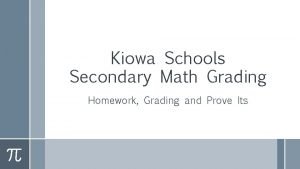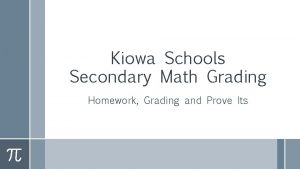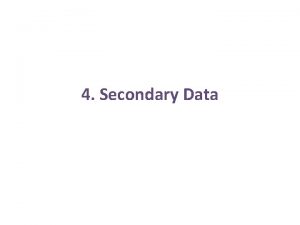Kiowa Schools Secondary Math Grading Homework Grading and













- Slides: 13

Kiowa Schools Secondary Math Grading Homework, Grading and Prove Its

Important Information for Parents and Students › Homework – Work 15% (. 15) of overall grade – Must be done correctly to receive credit – 100% credit given for completion within one week of the assignment being given – 50% credit given for work completed within two weeks of assignment being given – Can be redone as many times as needed for credit within the above time frames. – Priority in grading is given to new assignments being turned in, with late or redone homework graded second. – Students given 30 -40 minutes per class to work on the ten (average assignment) problems assigned as homework

Important Information Continued… › Prove It – Worth 85% (. 85) of the overall grade – Lowest score as a percentage is a 64% – Lowest score among the Learning Outcomes is the grade entered into the grade book. – Made up of clusters of problems related to specific learning outcomes that are averaged together to arrive at a score for each learning outcome on the Prove It (scores are rounded down, ex- 2. 2= 2. 0 – Scoring assigned based on a rubric designed for the specific Prove It – Can be redone as long as all homework related to the Prove It has been turned in – Can be redone as many times as a students wants › First and third quarter redos can be redone during the first three weeks of the second and fourth quarters. › No redos during the last week of any quarter – Students prioritize which learning outcomes and therefore problems they are going to correct and redo. Students DO NOT have to redo all or any problems on a Prove It if they are satisfied with their grade.

Combinations of Homework and Prove It scores that produce a passing or “Eligible” grade. 1. . 85 X. 77 (2. 0 - PI score) +. 15 X 1. 0 (100% on homework) =. 8045 = 81% 2. . 85 X. 77 (2. 0 PI score) +. 15 X. 7 (70% on homework) =. 7595 = 76% 3. . 85 X. 67 (1. 5 PI score) +. 15 X 1. 0 (100% on homework) =. 7195 = 72% 4. . 85 X. 67 (1. 5 PI score) +. 15 X. 7 (70% on homework) =. 6745 = 68% 5. . 85 X. 64 (1. 0, . 5, 0 PI score) +. 15 X 1. 0 (100% on homework)=. 694 = 69. 4% 6. . 85 X. 64 (1. 0, . 5, 0 PI score) +. 15 X. 7 (70% on homework) =. 649 = 65% 7. . 85 X. 64 (1. 0, . 5, 0 PI score) +. 15 X. 68 (68% on homework) =. 646 = 65% **Scoring combinations 5 through 7 can be achieved without attempting any of the problems on the Prove Its. **Students who complete their homework on time for 100% credit cannot ever be ineligible or fail a math class. ** Students who complete their homework on time for at least 68% of the total possible points cannot ever be ineligible or fail a math class. **Lowest score possible in a math class is 54. 4%. This means no homework done, no Prove Its attempted.

Prove It Scoring Rubric (example) 4. 0 Topic: Graphing Quadratics In addition to 3. 0, in-depth inferences and applications with success or ability to solve the problem more than one way 97% 3. 5 3. 0 97% w/ 1 score of 4 The 87% 2. 5 2. 0 77% There are no major errors or omissions regarding the simpler details and processes as the student: Recognizes or recalls specific terminology such as Quadratic function, parabola, vertex, axis of symmetry, maximum, minimum, standard form, vertex form, intercept form Performs basic processes such as Basic math facts (addition, subtraction, multiplication and division) Graph and name coordinates of ordered pairs Evaluate a function at a given value Multiply binomials Apply the distributive property However, the student exhibits major errors or omissions regarding the more complex ideas and processes. 1. 5 Partial understanding of 2. 0 content and some of the more complex 3. 0 ideas and processes 67% 1. 0 64% 0. 0 In addition to 3. 0 performance, in-depth inferences and applications with partial success students are expected to: (LO 11) Graph quadratic functions written in standard form. (LO 12) Graph quadratic functions written in vertex form. (LO 13) Graph quadratic functions written in intercept form. (LO 14) Identify key features of quadratic functions and graphs. (LO 15) Rewrite quadratic functions written in either vertex form or intercept form into standard form. student exhibits no major errors omissions. No major errors or omissions regarding 2. 0 content and partial knowledge of the 3. 0 content Partial knowledge of some of the simpler 2. 0 content but major errors or omissions regarding the 3. 0 content 0. 5 A partial understanding of the simpler 2. 0 content but no understanding of the 3. 0 content No understanding or skill demonstrated

Most Common Reasons Why Students Fail or are Carrying Low grades for Long Periods of Time. 1. Homework not done at all or not turned in within the two weeks given for full (one week) or half (two weeks) for credit. 2. Work time in class (typically 30 -40 minutes) not used appropriately. 3. Taking days or weeks to get the typically ten problems on an assignment done and/or corrected which delays the start of the Prove It redo process. 4. Having multiple assignments that need to be corrected at the same time. 5. Not studying for Prove Its (this comes from students self reporting a lack of studying) 6. Not understanding how to study for a math test (Prove It), despite being shown and instructed on how to study. 7. Absences- students who miss class are taking longer than is advised to get caught up. 8. Not using a planner or other organizational device to help get assignments in on time, do corrections in time for credit and start the redo process as soon as possible. **Note: Late or redone homework is graded after new assignments. **

Eligibility › Students who complete all of their homework for credit cannot, mathematically, be ineligible. This is true even if the student does not attempt any of the problems on their Prove Its. › If a Prove It falls on a Wednesday or Thursday students have the next two school days to do their corrections and redo the Prove It problems that are below a 1. 5. – Students have been instructed to prioritize which problems must be corrected for eligibility first and the rest at a later time – Prioritizing narrows the focus of the correction and redo process – If the student completes this process AND improves their Prove It score, they will be removed from the weekly ineligible list – Students appear on the list as a reminder to the student and to parents that the redo process must be completed in order to remain eligible. (Note: any week where the redo process is successfully completed does not count toward removal from a team or club)

The “Why” › Schools created generations of students trained to do work, get a score (grade) and move on. – Students got 20/30, 25/30 on their assignments – The issue comes from what is never learned in the 10 points not earned in the 20/30 or the 5 points in the 25/30 – Over 10 -12 years of math instruction and assessment gaps were created and never filled because the system didn’t care about the gaps and had no mechanism for filling in the gaps – This system requires students to go back and try to learn the things they are struggling to master – Common gaps include: fractions, decimals and percentages, ratios, order of operations

Why Must All Practice Problems Be Correct? “Each fall, a few ask to be given credit for ‘all that work’ that they put into incorrect solutions and complain about the ‘extra work’ of doing them over correctly. It’s not ‘practice makes perfect’ – wrong practice is worse than none! Perfect practice is what really makes perfect. ” -Marlo Warburton MATHEMATICS TEACHER, National Council of Teachers of Mathematics, March 2014 › Practice should be about quality, not quantity – we would rather students practice 10 problems correctly than do 30 incorrectly and have to “unlearn” › Encourages students to attempt the difficult problems › Encourages students to take the initiative in recognizing what they don’t understand ask for help

Additional Items › Average turnaround time for returning graded Prove Its and homework? – 1 -2 days depending on the length of the Prove It/assignment and possibly unforeseen factors. – Late and/or redone homework is graded after new assignments. › Process for notifying students/parents besides the ineligibility call? – Students have access to their grades and missing assignments online. – Parents have access to their students grades and missing assignments online. – In class reminders to students that they need to be correcting and redoing homework and Prove Its as soon as possible. – Teachers are noting for students when they have all of their homework done for a given Learning Outcome so that they know when they are able to start the redo process. › Is there a help time or tutoring available? – One of the math teachers stays after school on Monday, Tuesday and Wednesday (3: 454: 45) to help any students in need. Thursdays by appointment. – 2 nd hour in the HS we have both math teachers and two upper level students available to help – Last hour in the MS is a study hall for all students

Additional Items (cont. ) › When a student is sports ineligible is the student allowed to attend sports practice? – This is coach dependent, some require students to go get help and come to practice after. Some tell them to just get help. – Students are always allowed to miss practice to get help or complete redos. – Girls basketball practice starts at 4: 30 allowing students 45 minutes to get help form any teacher. › When a student is sports ineligible do we require the student to attend tutoring? – No. Students are responsible determining when they need help and therefore need to miss practice. – Students are always encouraged, but cannot be made to attend an afterschool tutoring time. › Is there a standard practice for coaches when a student is ineligible? – No. Some coaches go and check in with teachers to understand their classes and grading systems, others leave that up to students.

What Students Can Do To Be Successful…And Somethings To Avoid

Codes In Goedustar (Parents Online) And Their Meaning
 My story is one of many thousands
My story is one of many thousands Reno shemale
Reno shemale Reach safety schools
Reach safety schools Huntsville city schools powerschool
Huntsville city schools powerschool Homework oh homework i hate you you stink
Homework oh homework i hate you you stink Homework oh homework i hate you you stink
Homework oh homework i hate you you stink Jack prelutsky homework oh homework
Jack prelutsky homework oh homework Homework oh homework
Homework oh homework Alitteration definition
Alitteration definition Literal language examples
Literal language examples Level of education in malaysia
Level of education in malaysia Aims of economics
Aims of economics Did your homework finished last night
Did your homework finished last night Secondary school grading system
Secondary school grading system

























